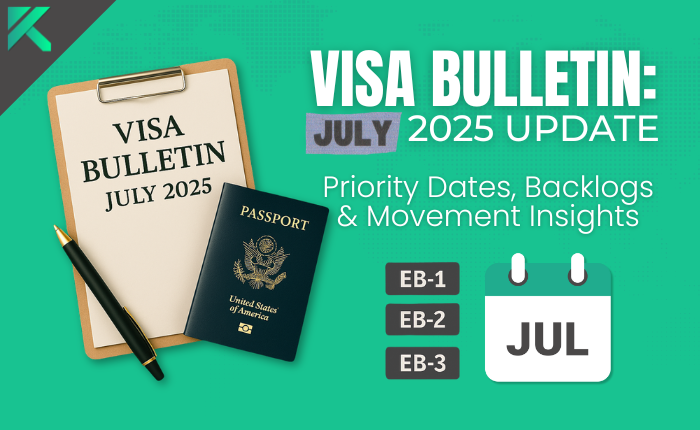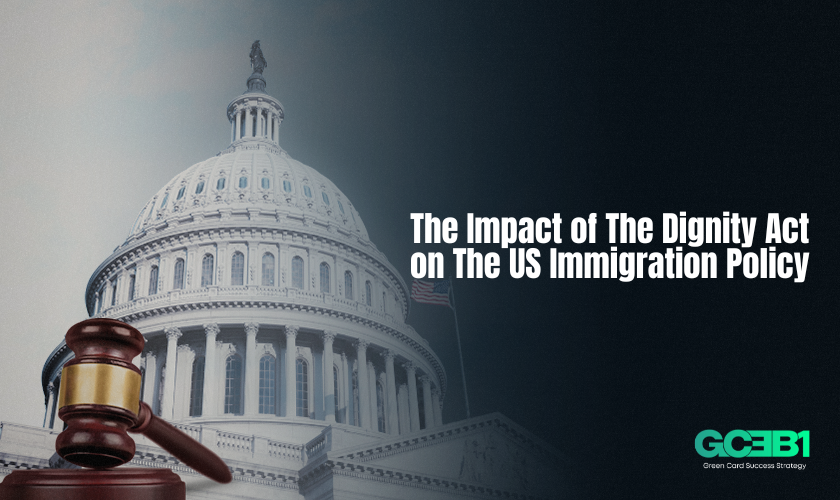May 2025 Visa Bulletin: Key Updates for India’s EB-1, EB-2 & EB-3 Applicants

The U.S. Department of State has now issued the May 2025 Visa Bulletin, which contains per-country cut-off dates governing the availability of immigrant visas and the flow of Adjustment of Status (AOS) applications and consular Immigrant Visa application interviews and approvals. Current priority dates held by a person applying for permanent residence must fall before the cut-off date specified in the monthly Visa Bulletin.
This latest US visa bulletin also describes the Final Action Dates that govern green card approvals. It is vital to track these updates throughout the U.S. immigration process. This blog is here to give you a brief overview of what these projections mean for EB-1A visa, EB-2, and EB-3 aspirants.
Understanding the Visa Bulletin
The U.S. Immigration Visa Bulletin is a monthly publication of the U.S. Department of State, providing information about visa number availability. The bulletin focuses on two key charts:
- Dates for Filing: These dates are mentioned in the Visa Bulletin. From here, if your priority date is before the cut-off date given for your category, you can take the next step in the application process. If your priority date is equal to the cut-off date, you are still not allowed to go forward in the application process.
- Final Action Dates: Besides that, the bulletin visa shows the so-called "Final Action Dates." This is an estimation of when your application will be processed and decided upon. So, the difference between those two dates probably mirrors the expected timing for USCIS processing.
When the priority date is current, two things can happen:
- Adjustment of Status: When you are already in the USA,
- Immigrant Visa processing: When you are outside the USA.
The Final Action Dates chart is what USCIS is going to apply for employment-based preference categories for May 2025.
EB-1: Priority Workers
The eb1 visa bulletin pertains to priority workers, including those with extraordinary ability, outstanding professors and researchers, and certain multinational executives and managers.
- India: The Final Action Date stands on 15th February 2022, with no changes from the last month.
Thus, this stagnation reflects sustained high demand and low availability of visas for Indian applicants in the EB1 green card visa bulletin category.
EB-2: Advanced Degree Professionals
The eb2 visa bulletin category is for advanced degree professionals and those with exceptional abilities.
- India: The Final Action Date stays at 1 January 2013, with no advancement.
EB-3: Skilled Workers and Professionals
The EB3 visa bulletin has skilled workers, professionals, and other workers.
- India: The Final Action Date has been pushed forward to 15 April 2013, two weeks forward from its previous date.
What Is Visa Retrogression?
Visa retrogression occurs when the demand for visas exceeds the supply in that category. When this happens, the government takes the step of moving the cutoff date backward to bring down the number of eligible applicants.
This time, in the current visa bulletin, a six-month retrogression took place for the EB-5 unreserved category. A reminder that even when your date gets current, it is time to keep pushing -- any delay could see you losing such precious time.
Implications for Indian Applicants
For Indian nationals seeking employment-based avenues for U.S. permanent residency, the Visa Bulletin for May 2025 has provided a mixed bag of good fortune and low trials. The EB-1 and EB-2 categories show no signs of advancing; no Final Action Dates are available for either. The result is heavy continued demand that forces the issue of the limited availability of visa numbers across the board, affecting skilled professionals and priority workers from India.
Meanwhile, the EB-3 category has made progress, with the Final Action Date moved ahead by two weeks. This small step, but with some bit of hope for those waiting in this line, the latest US visa bulletin is advisable for applicants to monitor and to consider referring this consultation to an immigration professional to find out some potential avenues:
- Category Changes: Determining whether they are eligible under any employment-based category.
- Alternative Visa Options: Investigating other self-sponsored immigrant categories that might allow for quicker processing.
- Adjustment of Status: Possible adjustment of status while in the U.S. to speed up the green card process.
Navigating the Green Card Process
Getting an employment-based immigrant visa, such as the EB1 visa, EB2, or EB3, involves several stages of lengthy documentation. Applicants should ordinarily expect to perform the following:
- PERM Labor Certification (for EB-2 and EB-3)
- Form I-140 (Immigrant Petition for Alien Worker)
- Visa Bulletin tracking to know when their priority date becomes current
- Adjustment of Status (Form I-485) or Consular Processing, depending on their location.
Understanding the up-to-date visa bulletin will be vital in knowing when to step into the next stage. The EB1 green card path, frequently taken by researchers, executives, or persons with extraordinary ability, circumvents the PERM stage, thereby being faster yet more competitive.
Facilitating the work of experienced professionals, such as the EB1 visa green card Consultancy experts, makes it easy to work without wasting much time and maximizes approval chances. It is about proper filing in terms of time updates and strategic planning.
If you need a helping hand from an expert, you can contact GCEB1 for EB-1A Green Card Consultancy services. Our customized service could be the breakthrough you are looking for.





.webp)
.png)

.png)
.png)
.webp)
.png)

